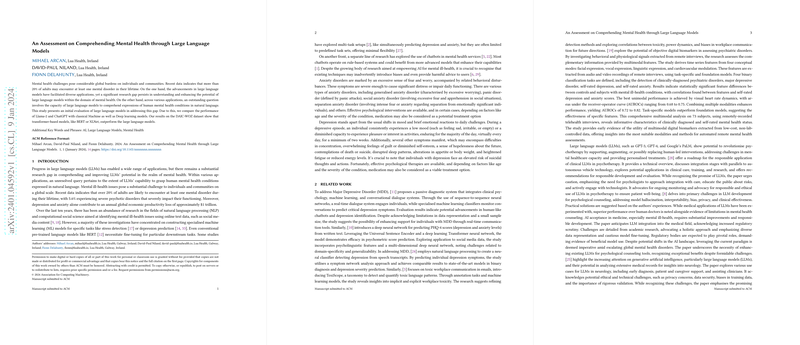Introduction
Developments in the field of AI have seen LLMs such as ChatGPT offering a broad spectrum of capabilities, influencing various sectors. Notably, there's an intersection of interest in the utilization of this technology for mental health applications. Mental health concerns are critical, with over 20% of adults potentially facing a form of mental disorder in their lifetime. Not only is the impact personal, but the economic toll is also significant, with disorders such as depression and anxiety leading to substantial productivity losses worldwide.
Analysis of LLMs for Mental Health Applications
The paper in focus has embarked on evaluating the competency of two renowned LLMs, Llama-2 and ChatGPT, against conventional Machine Learning and Deep Learning models. The cornerstone of investigation is these models' ability to interpret and assess mental health conditions from conversational text data, specifically from a dataset known as DAIC-WOZ, which includes transcribed interviews focusing on psychological distress conditions. A noteworthy aspect of the paper is the use of the PHQ-4 questionnaire as a reference for structuring prompts to the LLMs, which inquires about patients' experiences related to anxiety and depression.
Methodology and Results
The methodology section details data preprocessing techniques and the evaluation of various models. The innovative prompting techniques employed for LLMs are outlined, with the aim of eliciting precise responses reflective of the PHQ-4 scores related to anxiety and depression. The paper reveals that traditional Transformer-based models, including BERT and XLNet, display superior performance in comparison to LLMs such as Llama-2 and ChatGPT when tasked with interpreting symptoms of mental health conditions.
Conclusion and Reflections
The research provides compelling evidence suggesting that while LLMs have impressive capabilities in language comprehension, there's room for growth within the domain of mental health assessment. Transformer models, which have been fine-tuned for this specific application, seem to outperform larger LLMs at this juncture. It's important to recognize the sensitive nature of the data and the complexity of mental health, which could present significant barriers to achieving unbiased performance by these models. Future work is suggested to involve a deeper exploration of LLMs, aiming to overcome these challenges and improve their application in mental health contexts. The findings are fundamental, elucidating the path forward in both technological development and ethical considerations in the intersection of AI and mental health support.
